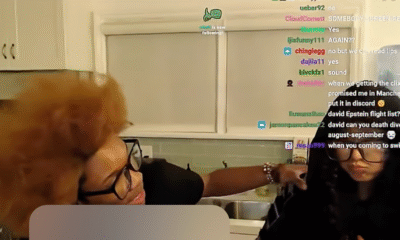News
The Ten Commandments in Schools: A Necessary Change or a Constitutional Violation?
The recent enactment of a Louisiana law mandating the display of the Ten Commandments in public school classrooms has ignited a national debate on the role of religion in education. This controversial legislation, signed by Governor Jeff Landry, requires all public K-12 classrooms and state-funded universities to prominently display the Ten Commandments. As legal challenges mount, the question remains: Is this law a necessary change to address moral decay, or does it violate constitutional principles?
Public Opinion and Religious Demographics
The law reflects a broader trend in public sentiment regarding religion in schools. According to a 2023 Pew Research Center survey, 37% of Americans believe there is too little religion in public education, while 31% think the current level is appropriate. This divide underscores the complex relationship between faith and public institutions in the United States.
Louisiana’s religious landscape plays a significant role in this debate. The state has a strong Christian majority, with approximately 84% of adults identifying as Christian, including 46% who are evangelical Protestants. Only about 13% of Louisiana residents are religiously unaffiliated, compared to the national average of 26%.
Legal Challenges and Constitutional Concerns
The law faces immediate legal challenges, with civil liberties groups, including the American Civil Liberties Union (ACLU), preparing to sue the state. These organizations argue that the law violates the First Amendment’s Establishment Clause, which prohibits the government from favoring one religion over others or non-religion.
Historically, similar laws have been struck down by the Supreme Court. In the 1980 case of Stone v. Graham, the Court ruled that a Kentucky law requiring the display of the Ten Commandments in public schools was unconstitutional. However, the current conservative majority on the Supreme Court may lead to a different interpretation of the Establishment Clause, potentially shifting towards a view that emphasizes historical practices.
Implementation and Requirements
The law specifies that the Ten Commandments must be displayed on posters at least 11 inches by 14 inches in size, using a large, easily readable font. Schools are not required to fund these displays themselves but can accept donations for their purchase. This provision attempts to navigate around previous court rulings that have restricted government funding of religious displays.
Addressing Moral Decay and Violence
Supporters of the law argue that the Ten Commandments are foundational to the legal and moral framework of the United States and that their display in schools can provide ethical guidance to students. Governor Landry and other proponents believe that the commandments can help address issues of moral decay and violence in schools by instilling a sense of right and wrong.
Statistics from the National Center for Education Statistics (NCES) indicate that incidents of violence in schools have been a growing concern. In the 2021-2022 school year, 20% of public schools reported at least one incident of physical attack or fight without a weapon, up from 15% in the 2015-2016 school year. Proponents argue that reinforcing moral values through the Ten Commandments could help mitigate such issues.
Broader Implications and National Trend
Louisiana’s law is part of a larger conservative Christian legislative movement gaining momentum in several states. For instance, Texas is considering similar mandates. This trend reflects a growing push to incorporate religious elements into public education, raising concerns about the impact on students from diverse religious backgrounds and those with no religious affiliation.
Educational Impact and Hidden Curriculum
Curriculum experts warn about the potential effects of this law on the “hidden curriculum” – the implicit lessons taught through school policies and practices. There are concerns that mandating religious displays could create an environment that feels hostile to non-Christian students, potentially undermining efforts to embrace religious diversity in public education.
As this debate unfolds, it highlights the ongoing tension between religious expression and secular governance in American public life. The outcome of Louisiana’s Ten Commandments law and similar initiatives across the country will likely have far-reaching implications for the interpretation of the First Amendment and the future of religious displays in public institutions.
While the intention behind the law may be to provide moral guidance to students, its implementation raises serious constitutional and ethical concerns. The ongoing legal battle will determine whether this approach is a necessary change to address moral decay and violence in schools or a violation of the foundational principles of religious freedom and separation of church and state.
News
From Failing 39 Times to Fortune: The Ultimate Comeback Story

In the world of entrepreneurship, failure often teaches more than success ever could. But for one relentless entrepreneur, failure wasn’t a chapter — it was 39 of them. What set his story apart was not just his endurance but his pivotal 40th business, which transformed $10,000 in savings into a $100 million empire within five years.

The Turning Point
After decades of setbacks across nearly forty ventures, he found inspiration in the most unexpected place — a meeting where someone blew what looked like smoke into the air. It wasn’t smoke at all — it was vapor from an electronic cigarette. He realized instantly that this was a revolution waiting to happen. That spark became the foundation for Logic, the brand that would eventually dominate the U.S. e-cigarette market.
Armed with just $10,000, he dove in headfirst. Instead of chasing investors or waiting for ideal conditions, he took a raw, hands-on approach. He spent twenty hours a day visiting stores, personally pitching his product: a safer alternative to traditional cigarettes. His enthusiasm was contagious — customers responded, retailers stocked up, and soon his brand was in thousands of locations nationwide.
The $10,000 Bet That Changed Everything
Unlike many startups that rely on outside funding, he bootstrapped his way forward. That $10,000 became his symbol of focus and scrappiness. Every sale mattered. Every conversation counted. And unlike businesses before it, this idea had a mission behind it — to help millions quit deadly cigarette habits through healthier alternatives.
Within 18 months, Logic reached over 100,000 distribution points. In less than five years, it crossed $100 million in revenue and was eventually acquired by Japan Tobacco through Goldman Sachs, a deal that validated every failure that came before it.

The “Focus Group” Hack That Made History
One of his most genius moves wasn’t about technology at all — it was marketing mastery. Without the funds for a formal focus group, he looked for a loophole that would give him legitimacy in the marketplace. Instead of spending $250,000 on a focus group study, he trademarked the phrase “The Most Trusted Brand” under the electronic cigarette category. Because it was a registered brand, he could legally make that claim — no focus group needed.
This trademark became a powerful differentiator. Soon, the slogan appeared on 2,000 New York City taxis, wrapping the streets in brand visibility. Retailers across the East Coast recognized it, and the brand’s credibility skyrocketed overnight, all thanks to one creative legal maneuver.
Lessons from the 40th Business
His story underscores a timeless entrepreneurial truth: persistence always beats perfection. The 39 failed ventures weren’t wasted — they honed his instincts, sharpened his resilience, and taught him how to recognize opportunity when it appeared.
From guerrilla marketing to working store-to-store, his journey reflects the grit every entrepreneur must channel to break through. When the 40th business finally hit, it wasn’t luck — it was the cumulative reward of decades of failure, refined into wisdom.
His words capture the essence of his journey best: “Volume negates luck. Every no is a step closer to a yes.” After 39 failures, that 40th “yes” became the billion-dollar answer he had worked his whole life to find.
Entertainment
Selling Your Soul in Hollywood: The Hidden Cost of Fame

By all appearances, Hollywood is a dream factory — a place where charisma, talent, and luck collide to create stars. But behind the camera lights and red carpets lies a conversation few inside the industry speak openly about: the spiritual and moral price of ambition.

For actor Omar Gooding, the idea of “selling your soul” in Hollywood isn’t a metaphor — it’s a moral process that begins with tiny compromises. In an October 2025 interview, Gooding explained that no one in Hollywood makes a literal deal with the devil. Instead, it’s the quiet yeses, the moments when comfort overrides conviction, that mark the beginning of the trade. “They don’t say, ‘Take this or you’ll never make it,’” he said. “They just put it in front of you. You choose.”
Those choices, he argues, create a pattern. Once you show that you’ll accept something you once resisted, the industry notices. “Hollywood knows who it can get away with what,” Gooding said. “One thing always leads to another.” The phrase “selling your soul,” in this context, means losing your say — doing what you’re told rather than what you believe in.
That moral tension has long shadowed the arts. Comedians like Dave Chappelle, who famously walked away from millions to preserve his creative integrity, often serve as examples of where conviction and career collide. In resurfaced interviews, Chappelle hinted that he felt manipulated and silenced by powerful figures who sought control of his narrative, warning that “they’re trying to convince me I’m insane.”
This isn’t just about conspiracy — it’s about agency. Hollywood runs on perception. Performers are rewarded for being agreeable, moldable, entertaining. Those who question the machine or refuse the script risk exile, while those who conform are elevated — sometimes beyond what they can handle.
“We see the ‘collections’ all the time,” Gooding explained. “When the bill comes due, you can tell. They made that deal long ago.”

But the story doesn’t end in darkness. Gooding also emphasizes that in today’s entertainment landscape, artists have more control than ever. With streaming, social media, and creator‑driven platforms, performers don’t have to “play the game” to be seen. Independent creators can build their own stages, speak their own truths, and reach millions without trading authenticity for access.
Still, the temptation remains — recognition, validation, quick success. And every generation of artists must answer the same question: What are you willing to do for fame?
As Gooding put it, “You just make the best choices you can. Because once it’s gone — your name, your peace, your soul — there’s no buying it back.”
Entertainment
California Bans AI Clones from Replacing Real Talent

California just made a dramatic stand for human creativity, defeating the threat of AI actor clones with a sweeping new law that puts people—not algorithms—back in the Hollywood spotlight. With the stroke of Governor Gavin Newsom’s pen in October 2025, the state has sent a clear message to studios, tech companies, and the world: entertainment’s heart belongs to those who create and perform, not to digital facsimiles.
California Draws a Hard Line: No More AI Clones
For months, the entertainment industry has been divided over the use of artificial intelligence in filmmaking. Studios, lured by promises of cost-cutting and creative flexibility, have invested in software that can mimic an actor’s face, voice, and even emotional range. But for performers, this wave of synthetic reproduction has triggered alarm—encouraged by chilling stories of deepfakes, unauthorized digital doubles, and contracts that let studios reuse a star’s likeness indefinitely, sometimes without pay or approval.
The new California law, anchored by AB 2602 and AB 1836, changes everything:
- Every contract must explicitly detail how studios can use digital replicas or voice models, preventing once-common “blank check” agreements that overlooked this risk.
- No one—not studios nor streaming giants—can create or release AI-generated clones of an actor, living or dead, without clear, written consent from the performer or their estate.
- The law gives families new powers to defend loved ones from posthumous deepfake exploitation, closing painful loopholes that once let virtual versions of late icons appear in new ads, films, or games.
Actors Celebrate a Major Victory
The legislation rides the momentum of the recent SAG-AFTRA strike, where real-life talent demanded control over their own digital destinies. Leaders say these protections will empower artists to negotiate fair contracts and refuse participation in projects that cross ethical lines, restoring dignity and choice in an industry threatened by silent algorithms.
Stars, unions, and advocacy groups are hailing the law as the most robust defense yet against unwanted AI replications.
As one actor put it, “This isn’t just about money—it’s about identity, legacy, and respect for real artists in a synthetic age.”
A New Chapter for the Entertainment Industry
California’s move isn’t just a victory for local talent—it’s a warning shot to studios everywhere. Companies will now be forced to rethink production pipelines, consult legal counsel, and obtain proper clearance before digitally cloning anyone. Global entertainment platforms and tech developers will need to comply if they want to do business in the world’s entertainment capital.

These laws also set a template likely to ripple through other creative fields, from musicians whose voices can be synthesized to writers whose work could be mimicked by generative AI. For now, California performers finally have a powerful shield, ready to fight for the right to shape their own public image.
Conclusion: Human Talent Takes Center Stage
With its no-nonsense ban on AI actor clones, California draws a bold line, championing the work, likeness, and very humanity of its creative stars. It’s a landmark step that forces the entertainment industry to choose: respect real talent, or face real consequences. The age of the consentless digital double is over—human performers remain the true source of Hollywood magic.

 Business4 weeks ago
Business4 weeks agoDisney Loses $3.87 Billion as Subscription Cancellations Surge After Kimmel Suspension

 Entertainment4 weeks ago
Entertainment4 weeks agoWhat the Deletion Frenzy Reveals in the David and Celeste Tragedy

 Entertainment4 weeks ago
Entertainment4 weeks agoExecutive Producer Debut: How Celia Carver Created Festival Hit ‘Afterparty’

 Health4 weeks ago
Health4 weeks agoRussia Claims 100% Success With New mRNA Cancer Vaccine

 Business3 weeks ago
Business3 weeks agoWhy Are Influencers Getting $7K to Post About Israel?

 Health4 weeks ago
Health4 weeks agoWhy Did Gen Z QUIT Drinking Alcohol?

 Advice4 weeks ago
Advice4 weeks agoHow AI Is Forcing Everyone Into the Entrepreneur Game

 Entertainment3 weeks ago
Entertainment3 weeks agoKeith Urban and Nicole Kidman Split After 20 Years as Actress Files for Divorce







































